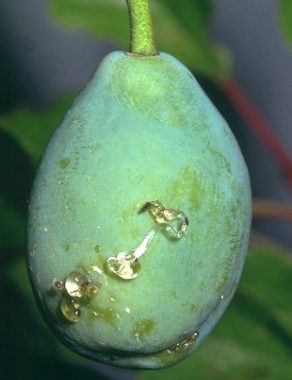
Carpocapsa
WHAT IT IS AND HOW TO ELIMINATE
Ciruela
Carpocapsa
Cydia Pomonella
Pathogen:
Insect
Type:
Risk to the plant:
CRITICAL
Polillas

WHO CAUSES IT?
Cydia pomonella, commonly known as the codling moth, is an insect that belongs to the Tortricidae family. Adults are small moths approximately 10 mm long with gray wings and dark transverse bands. The eggs, oval in shape and creamy white in color, are laid individually on or near the fruits. Once the eggs hatch, the larvae emerge and begin boring into the fruit in search of seeds, causing significant damage. These larvae are creamy white with a dark brown head and go through five larval instars before leaving the fruit to pupate in the soil or in cracks in the tree bark. Pupation occurs in a silk cocoon, where the larvae overwinter. In spring, they emerge as adults ready to start a new cycle. The development of Cydia pomonella is highly influenced by temperature, with one or two generations per year depending on the climate.
SYMPTOMS
Codling moth causes serious damage to plums, compromising both the quality and quantity of the harvest. The larvae feed on the inside of the fruit, resulting in premature fruit drop and decay. The presence of larvae also facilitates the entry of other pathogens, which aggravates the damage.
- Entry and exit holes in the fruits.
- Presence of excrement and sawdust at the entry point.
- Premature fall of infested fruits.
- Internal damage to the fruits, with tunnels that lead to the seeds.
- Decomposition and rotting of affected fruits.
- Loss of commercial quality of the fruit.
- Significant reduction in total production.



DEVELOPMENT CONDITIONS
Temperature:
20-30°C
Humidity:
60-80%
HOW IS IT SPREAD?
Wind, movement of infected fruits, contaminated agricultural tools, nursery material, direct contact between plants
HOW TO ELIMINATE IT?
Home treatments
Natural allies
Chemical treatments
RECOMMENDED PRODUCTS TO ELIMINATE THE PEST
PLANTAS REPELENTES
-
RECOMMENDATIONS
- Check your plants frequently for caterpillars or early damage
- Remove the caterpillars by hand if there are few of them and destroy them
- Use light traps or pheromones to attract adult moths
- Attracts beneficial insects such as parasitoid wasps or ladybugs
- Keep the crop clean and free of remains of old plants
- Apply natural extracts such as neem or Bacillus thuringiensis, a safe biological product
- If the damage is severe, consult a technician to use specific products safely



















